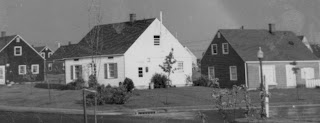
By Kathy Stahlman Zinn '63
While going through my only Division Avenue High School yearbook, from 1961, my sophomore and last year there before I moved away, I read the address principal James Reilly had written and was impressed.
He had always struck me as a formal, straight-laced, almost stern, man. I greatly respected him, as did almost everyone else. He ran a "tight ship", which must have been very important, since he oversaw the transition of Division Avenue School from a junior high to a full Junior/Senior High School, in 1960.
I know I felt very secure there, and as if everything was in order. They say the principal of the school sets the tone, and I certainly think he did. I did learn one thing personal about him that year. Our band had been invited, for the first time, to play in the famed St. Patrick's Day parade in New York City. We learned, probably from Mr. East, our band director, that this was due to Mr. Reilly's membership in the "Ancient Order of Hibernians".
I had no idea what that was. However, my New York City Irish-American mother certainly did. It was an Irish Society of great prestige. I learned many years later that "Hibernia" was the Latin name for Ireland. There is a picture of our band in the same yearbook, marching down Fifth Avenue. What it doesn't show is how very cold it was. I have a memory of Mr. Reilly, in a jaunty hat, accompanying us, and with a big grin on his face. I realize now he could have been no more than in his mid 40s. Many of us have children that age now. But that band memory showed him being smiley and jolly - a real Irishman that day.
It wasn't until I read this 1961 yearbook piece that I realized what a wordsmith he was (an Irish characteristic - some call it blarney, but I prefer to think of it as a love of language). I also realized how deeply he felt about the mission of his school, of Levittown, of our own parents, and especially of himself, in educating us to "serve your fellow . . . citizens. "
I learned from Frank Barning, '60, that Mr. Reilly had also been a teacher at Division. I had never thought of him as anything but The Principal. Frank wrote: "Mr. Reilly was a fine English teacher and a respected administrator. I had him for seventh grade English and he ran a great class. He was the sort of teacher I hoped to have more than once, but that did not happen. He was a sharp, professional dresser, always carefully groomed. He would be shocked at what teachers and students have devolved into over the years. His message in the 1960 yearbook was about pioneering, since we were DAHS's pioneer class. In short, Mr. Reilly was a class act."
Here is what Mr. Reilly wrote: Dear Graduates of 1961:
Thirteen years ago a young, eager, and idealistic group of mothers and fathers, perhaps with some of you in tow, began a great adventure of living in an unheard of area called Levittown. No doubt those first days of muddy roads, balky oil burners, too-distant stores for food and clothing wavered even the strongest among the pioneers of our community. But the tenacity and the ingenuity that had brought them through a great war turned to the exciting task of building a bright new world of green lawns and gaily decorated Cape Cod homes.
In time, recognition and respect, yes, even envy, were the rewards of this model community. As members of this exciting dream come to fruition, your life has been made fuller and richer by the efforts and sacrifices and ideals of your parents and of the thousands of nameless but active, generous citizens of our community who have built around you a world of love-filled homes, of inspiring houses of worship, of extensive recreational facilities, of quality schools.
We are inspired to seek the heights of achievement by the priceless example of those who contribute to our growth from love and generosity and sacrifice; we in turn from the well spring of gratitude and from the human desire to contribute to a better life must inspire those who follow us by our total and complete flowering of talent and ability for the benefit of all.
We of the school staff have, in joy and in pain, molded you in the image of your community and inspired you in the spirit that is its essence to serve your fellows as thinking, sensitive and giving citizens who may boldly approach their own bright new world as their fathers did before them.
God grant that though you know us for our feet of clay we have shown you the shining beauty of the stars.***
It was our good fortune to have had James R. Reilly as our school's leader in a time of transition. He was a class act, indeed.
 click on photo to enlarge
click on photo to enlarge



























